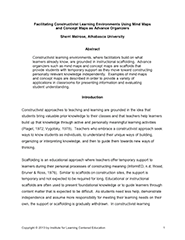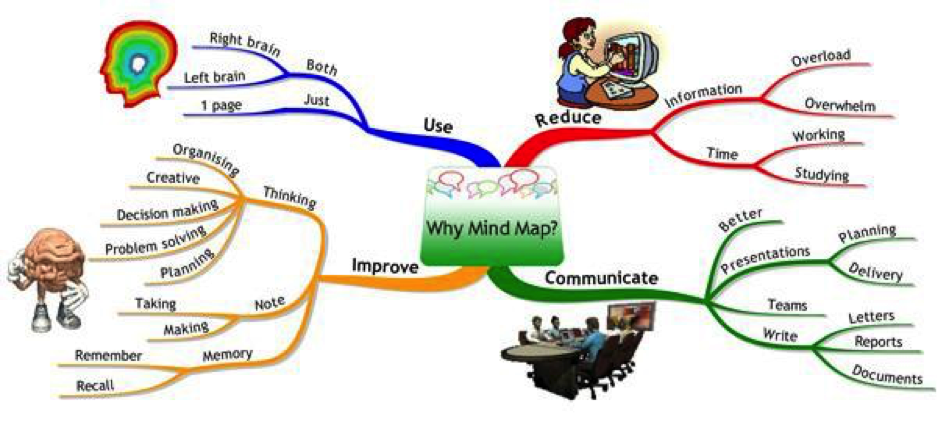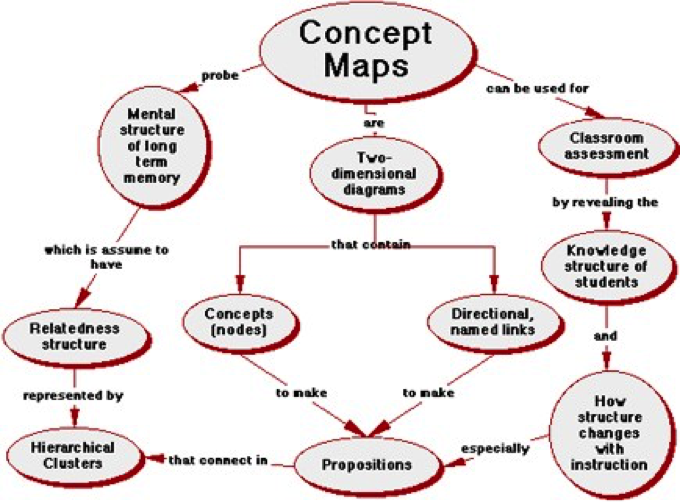3

Citation
Melrose, S. (2013). Facilitating constructivist learning environments using mind maps and concept maps as advance organizers. JPACTe Journal for the Practical Application of Constructivist Theory in Education, 7(1).
Abstract
Constructivist learning environments, where facilitators build on what learners already know, are grounded in instructional scaffolding. Advance organizers such as mind maps and concept maps are scaffolds that provide students with temporary support as they move toward constructing personally relevant knowledge independently. Examples of mind maps and concept maps are described in order to provide a variety of applications in classrooms for presenting information and evaluating student understanding.
Introduction
Constructivist approaches to teaching and learning are grounded in the idea that students bring valuable prior knowledge to their classes and that teachers help learners build up that knowledge through active and personally meaningful learning activities (Piaget, 1972; Vygotsky, 1978). Teachers who embrace a constructivist approach seek ways to know students as individuals, to understand their unique ways of building, organizing or interpreting knowledge, and then to guide them towards new ways of thinking.
Scaffolding is an educational approach where teachers offer temporary support to learners during their personal processes of constructing meaning (InformED, n.d; Wood, Bruner & Ross, 1976). Similar to scaffolds on construction sites, the support is temporary and not expected to be required for long. Educational or instructional scaffolds are often used to present foundational knowledge or to guide learners through content matter that is expected to be difficult. As students need less help, demonstrate independence and assume more responsibility for meeting their learning needs on their own, the support or scaffolding is gradually withdrawn. In constructivist learning environments, advance organizers provide adaptable, efficient and creative scaffolds for a variety of different learners.
This article explains and differentiates between two advance organizers: mind maps and concept maps. In order to help teachers decide when to implement mind maps and concept maps, a variety of applications relevant to teachers from K-12 through to college are discussed. Strategies for using maps as presentation strategies as well as for using them as evaluation strategies are described.
Advance Organizers
Constructivist facilitators can create scaffolds or support for understanding new information by emphasizing what it is about an area of content that is particularly important. Knowing aspects of a topic that can be expected to be difficult or complex, educators can organize that information in ways that offer learners a different way of looking at the material. Most educators create and present advance organizers such as charts, diagrams or other visual tools for organizing and representing consensually validated knowledge into their teaching practice. Similarly, creating and presenting summaries of course content material into a concise Power Point or Prezi presentation is another common way of incorporating advance organizers that incorporate a graphic or visual element.
Extending the usual teaching practice of providing general overviews or summaries of course material, theorist David Ausubel (1960, 1968) suggested that learners can come to understand ideas, concepts and principles more deeply and more meaningfully when advance organizers include both a reminder about relevant prior knowledge and an emphasis on the relationships that exist among concepts. To this end a learning activity that guides students to recall what they already know about a course topic is an advance organizer. Mind maps and concept maps are two different kinds of graphic advance organizers that help learners assimilate what they already know and what they are about to learn (Davies, 2011).
Mind maps
Mind maps, introduced by popular author Tony Buzan (2000), are informal intuitive diagrams used to represent only one single word or idea. Mind maps, like web or spider diagrams incorporate colors, symbols and pictures and are often used as tools for taking notes, for illustrating brainstorming activities or for sketching out thinking. The focus is on creating a visual representation of how relationships exist among ideas.
Construction of a mind map begins by identifying a central word or concept and then later adding descriptions associated with the concept. Colors and pictures can be included. Online tools with mapping templates are readily available for students and teachers. For example, Figure 1 is an example of a mind map titled Why Mind Map available on the Illumine Training Mind Mapping website (n.d.).
Figure 1
Mind Map: Why Mind Map?

Concept maps
By contrast, concept maps, introduced by science educators Joe Novak and Bob Gowan (1984) do not represent only one single word or idea. Rather, concept maps connect multiple words or ideas. Concept maps are hierarchical schematic diagrams that use words or symbols to represent key concepts. Concept maps also use linking words to show the relationship between concepts which then produce meaningful statements or propositions (Novak & Cañas, 2008). With their emphasis on illustrating the relationships, connections and patterns among ideas, concept maps can be considered more complex advance organizers. Figure 2 is a concept map Professor Michael Zeilik at the University of New Mexico created with IHMC CmapTools (IHMC CmapTools, n.d.), a free program, to explain concept maps.
Figure 2
Concept Map of Concept Maps

Michael Zeilik (n.d.)
http://www.flaguide.org/extra/download/cat/conmap/conmap.pdf
Reproduced with permission
Differences between mind maps and concept maps
As the above maps illustrate, mind maps and concept maps are different. Buzan’s (2000) informal mind maps were developed to illustrate one key idea and brainstorm key points associated with that one idea. On the other hand, Novak and Gowan’s (1984) concept maps, sometimes referred to as Novakian concept maps, were developed to illustrate several key concepts and use carefully contrived linking words to illustrate how relationships exist among the concepts. Notice how the concepts identified in Zeilik’s (n.d.) concept map (Figure 2) provide a clear statement when following the arrows. For example, “Concept maps can be used for Classroom assessment by revealing the Knowledge structure of students…” Without efficient and explanatory linking words, Novakian concept maps are incomplete.
Simple mind maps, where sub-topics radiate around one central image are fairly concrete, less rule bound and can be created immediately. Mind maps can capture and record a jumble of freewheeling ideas as they occur. By contrast, Novakian concept maps are more abstract, require thoughtful reflection and can be time consuming. The process of accurately illustrating cross-links and connections among sub-topics calls for a deeper and more systemic understanding.
Comparing the advantages and disadvantages of mind maps with concept maps, Eppler (2006) identified that advantages of mind maps include that they are easy to learn, apply and expand; encourage self-expression; and provide useful overviews of topics. Disadvantages of mind maps include that they can be idiosyncratic and hard for others to read; represent mainly hierarchic relationships; be inconsistent; and be overly complex.
Advantages of concept maps include that they can offer rapid information; provide an overview using a proven systemic approach; emphasize relationships and connections among concepts; and their evaluation rules afford viewers an ability to assess quality. Disadvantages of concept maps include that they also can be idiosyncratic, not easy for novices to apply, and time consuming both for learners to create and for educators to evaluate. In addition, the overall pattern of a concept map does not necessarily assist memorability (Eppler, 2006). Weighing the advantages and disadvantages of these tools is an important consideration as educators decide which advance organizer might best suit a particular instructional activity. In the following section, applications of mind maps and concept maps are discussed. Examples of these two scaffolding techniques in both K- 12 and college classrooms are presented.
Applying Mind Maps and Concept Maps in the Classroom
Constructivist teachers can use advance organizers such as mind maps or concept maps in different classrooms and in a variety of ways. The tools can be applied as presentation strategies where information is shared with learners and as evaluation strategies to assess learner understanding.
Presentation strategies
Passive presentations. Teachers can create their own conceptualization of knowledge related to a particular topic by drafting mind maps and or concept maps and then sharing the maps with students. This sharing can be done passively by displaying the maps in classrooms as posters. In brick and mortar classrooms the map posters can be taped to walls. In virtual classrooms, the map posters can be posted in forums or discussion areas. Collections of maps can be made available in libraries or resource centers for students to access outside of class. By sharing their own ways of piecing together information through maps, teachers model new ways of thinking.
Mind maps, with their radiant display of ideas related to a central topic would be best suited to posters that loosely expand on that central topic. For example, in K-12 classrooms, sub-topics related to a key theme inherent in a book the class is reading could be drafted. Similarly, in preparation for a science fair, mind maps illustrating different ways a particular science topic can be explored in depth will inspire students as they plan their exhibits.
In college classrooms, teachers can use mind map posters to summarize new research ideas they learned after attending an academic conference on a course topic. Additionally, for new students in professional programs, teacher-constructed mind maps can provide students with a bigger picture of the kinds of sub-topics they will need to know about in order to achieve disciplinary knowledge. In speciality areas such as health care programs, teacher-constructed mind maps can effectively illustrate a holistic approach to treatment by literally drawing patients in the center and surrounding them with health issues needing attention. Research has indicated that students who used teacher-constructed mind maps as study aids scored higher on quizzes than those who did not (Boley, 2008). Further, passive presentations of concept maps, where emphasis is placed on how sub-topics relate to one another, would be most suited to illustrating complex topics.
By contrast, teacher-constructed concept maps can be used to introduce content students can expect to learn more about and then to summarize that content once it has been presented. For example, in both K-12 and college classrooms, concept map handouts can serve as the foundation for a lecture. After the main topic has been explained, teachers can lift up sub-topics and expand on connections. At the end of each separate explanation, the process of referring back to the overarching concept map will help establish a sense of unity and consistency. When students face the difficult task of sorting through a large volume of information on a topic, both pre-made mind maps and pre-made concept maps can discreetly provide valuable and needed scaffolding.
Active presentations. In addition to providing pre-made maps, constructivist teachers can actively involve students in co-creating mind maps and concept maps. In class groups, teachers can supply a set of related concepts and call for student input to arrange them either radiantly in mind maps or hierarchically in concept maps. Or, teachers can generate the concepts for either type of map from students’ comments through brainstorming sessions. The teaching action of calling for student input brings students’ prior knowledge into focus and helps them construct new knowledge from what they already know.
Mind maps are generally considered best used at the beginning or planning phase of learners’ conceptualization process and concept maps at the ending or summarizing phase. However, their application need not be restricted to specific contexts. A more important factor is likely to be individual teachers’ commitment to and comfort with using the tools.
Individually, maps can support communication between students and teachers. Some learners find they learn more from actively constructing maps on their own rather than in interactive groups (Jones, Ruff, Snyder, Petrich, Koonce, 2012). Mind maps can be effective strategies for note-taking in classrooms from K-12 through to college. When teachers review mind map notes, they can see at a glance how subject matter has resonated with their audience.
It is important to note that reaction to the use of mind maps is not always conclusive or positive. For example, although mind-mapping is gaining popularity as a note-taking tool in medical schools, and students expressed that they found the tool useful, research revealed that mind mapping did not actually increase short term recall or critical thinking (D’Antoni, Zipp, Olson & Cahill, 2010; Wickramasinghe, Widanapathirana, Kuruppu, Liyanage, & Karunathilake, 2007).
Mind maps can serve as efficient planning tools. As students plan reports they will submit, teachers can review successive drafts of their planning maps. If an area needs further development, teachers can readily identify the gap before the work is graded.
For younger and more concrete-thinking learners, the colors and images can help students feel engaged. For older and more abstract-thinking learners, the freedom from inserting information in the “correct” way can help them feel confident. In one PhD program, teachers used mind maps for ‘pre-analytic idea jostles’ to stimulate ideas for literature reviews (Eppler, 2006). Learners at any level could benefit from individual or group discussions of information sources available to them as they begin an assignment.
Evaluation Strategies
When assignments invite students to synthesize what they have learned into their own advance organizers, the process of completing those assignments can become creative and imaginative as well as analytic and evaluative. As mentioned previously, ongoing teacher input into students’ maps provides valuable scaffolding and support. Rather than grading maps only when they are complete, evaluation strategies using mapping tools are most effective when they include formative components. Educational measurement of assignment maps is not straightforward. However, identifying improvement and increased knowledge from one submission to the next can be more clear-cut.
Mind maps are most suitable as an evaluation strategy when they illustrate topics that fit into a traditional course outline. Conversely, concept maps are most suitable as an evaluation strategy when they illustrate topics students have explored in depth by delineating relationships among sub-topics. For example, in a health related class, a mind map assignment could require portrayal of a case study, while a concept map assignment could require portrayal of a an illness. In both instances, including components where students present their maps to the rest of class and where they also present work in traditional text-based papers will strengthen the value of the exercise.
Rubrics for grading maps should include balanced criteria that address design as well as understanding. Numerous computer programs are available to assist learners to design mind maps and concept maps. If the purpose of an assignment includes demonstrating competency with these programs, this should be clear. In most instances, however, the purpose of a mapping assignment centres on demonstrating understanding. Without substance, beautifully hand-sketched or computer-generated maps likely reflect superficial comprehension and need further instructional scaffolding.
Conclusion
Constructivist thinking is a process where learners build on what they already know by participating in active and personally relevant learning experiences. Instructional scaffolding, or offering temporary support until learners are able to complete activities independently, is needed most in areas that students typically find difficult. Advance organizers are adaptable instructional scaffolds that teachers can readily implement in their classrooms. Advance organizers, such as simple mind maps that illustrate one key idea, or more complex concept maps that illustrate relationships among concepts, can be used to organize information. Teachers from K-12 through college can apply mind maps and concept maps to present information and to evaluate student understanding.
References
Ausubel, D.P. (1960). The use of advance organizers in the learning and retention of meaningful verbal material. Journal of Educational Psychology, 51, 267-272.
Ausubel, D.P. (1968). Educational psychology: A cognitive view. New York: Holt, Rinehart & Winston.
Boley, D.A. (2008). Use of premade mind maps to enhance simulation learning. Nurse Educator, 33, 220-223.
Buzan, T., & Buzan, B. (2006). The mind map book. Boston: Pearson Education.
D’Antoni, A.V., Zipp, G.P., Olson, V.G., & Cahill, T.F. (2010). Does the mind map learning strategy facilitate information retrieval and critical thinking in medical students? BMC Medical Education, 10, 61-71.
Davies, M. (2011). Concept mapping, mind mapping and argument mapping: What are the differences and why do they matter? Higher Education, 62(3), 279-301.
Eppler, M. (2006). A comparison between concept maps, mind maps, onetual diagrams and visual metaphors as complementary tools for knowledge construction and sharing. Information Visualization, 5, 202-210.
Illumine Training Mind Mapping (n.d.) Why Mind Map. Example mind map available at http://www.mind-mapping.co.uk/mind-maps-examples/about-mind-maps.htm.
InformED (n.d.) Definition of Scaffolding. Instructional Scaffolding. Teacher Resources tab. Available on the Open Colleges, Sydney Australia website at http://www.opencolleges.edu.au/informed/teacher-resources/scaffolding-in-education-a-definitive-guide/#ixzz2Xu212wpN
Jones, B., Ruff, C., Snyder, J.D., Petrich, B. & Koonce, C. (2012). The effects of mind mapping activities on students’ motivation. International Journal for the Scholarship of Teaching and Learning, 6(1). Retrieved from http://academics.georgiasouthern.edu/ijsotl/v6n1/articles/Jones_et_al/index.html
Novak, J.D., & Gowan, B. (1984). Learning how to learn. Cambridge MA: Cambridge University Press.
Novak, J. D., & A. J. Cañas, A. (2008). The theory underlying concept maps and how to construct and use them. Technical Report IHMC CmapTools 2006-01 Rev 01- 2008, Florida: Institute for Human and Machine Cognition. Available at: http://cmap.ihmc.us/Publications/ResearchPapers/TheoryUnderlyingConceptMaps.pdf
Piaget, J. (1972). Psychology and epistemology: Toward a theory of knowledge. Harmondsworth: Penguin.
Vygotsky, L.S. (1978). Mind and society: The development of higher psychological processes. Cambridge, MA: Harvard University Press.
Wickramasinghe, A., Widanapathirana, N., Kuruppu, O., Liyanage, I. & Karunathilake, I.M. (2007) Effectiveness of mind maps as a learning tool for medical students, South East Asian Journal of Medical Education, 1 (1), pp 30-32.
Wood, D., Bruner, J.S., & Ross, G. (1976). The role of tutoring in problem solving. Journal of Psychology and Psychiatry. 17(2), 89-100.
Zeilik, M. (n.d.). Classroom assessment techniques Concept mapping. Retrieved from Michael Zeilik’s website, Department of Physics and Astronomy, University of New Mexico.
